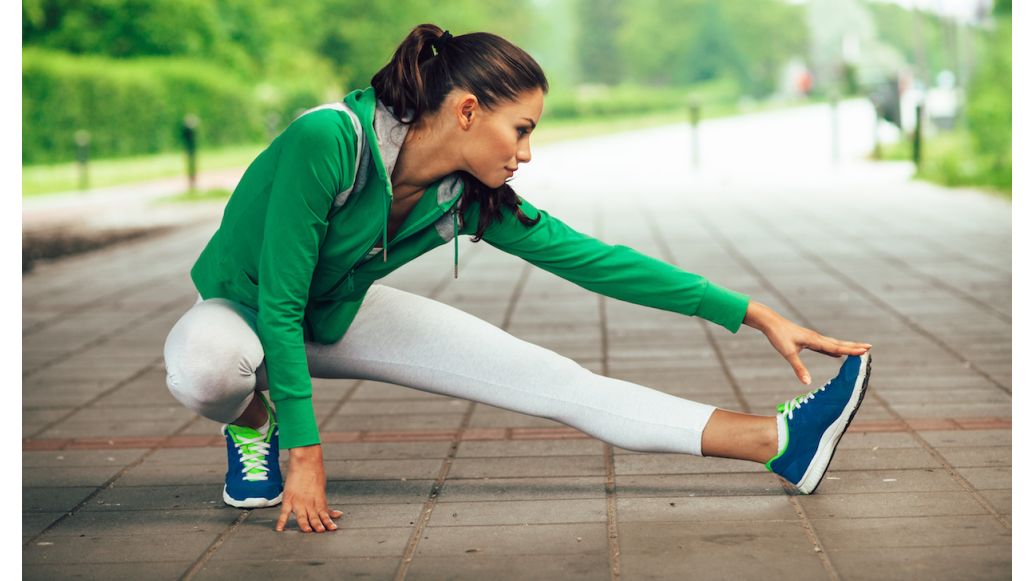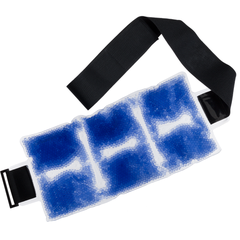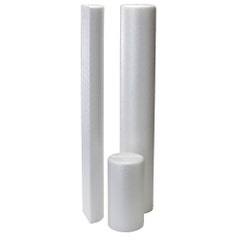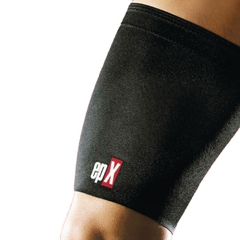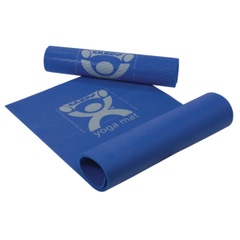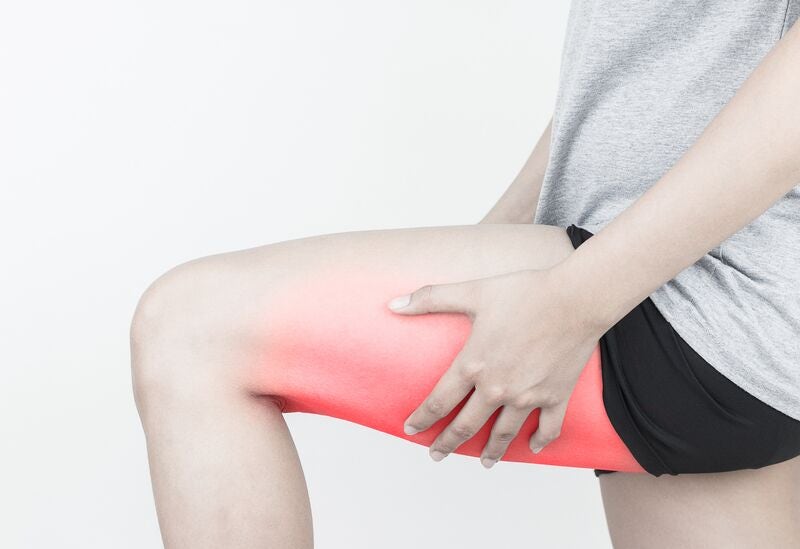If your hamstring hurts, it’s time to treat it now. Waiting until the pain gets worse will only lengthen your recovery time. Try these tips and exercises so you can return to running without pain.
FAQ
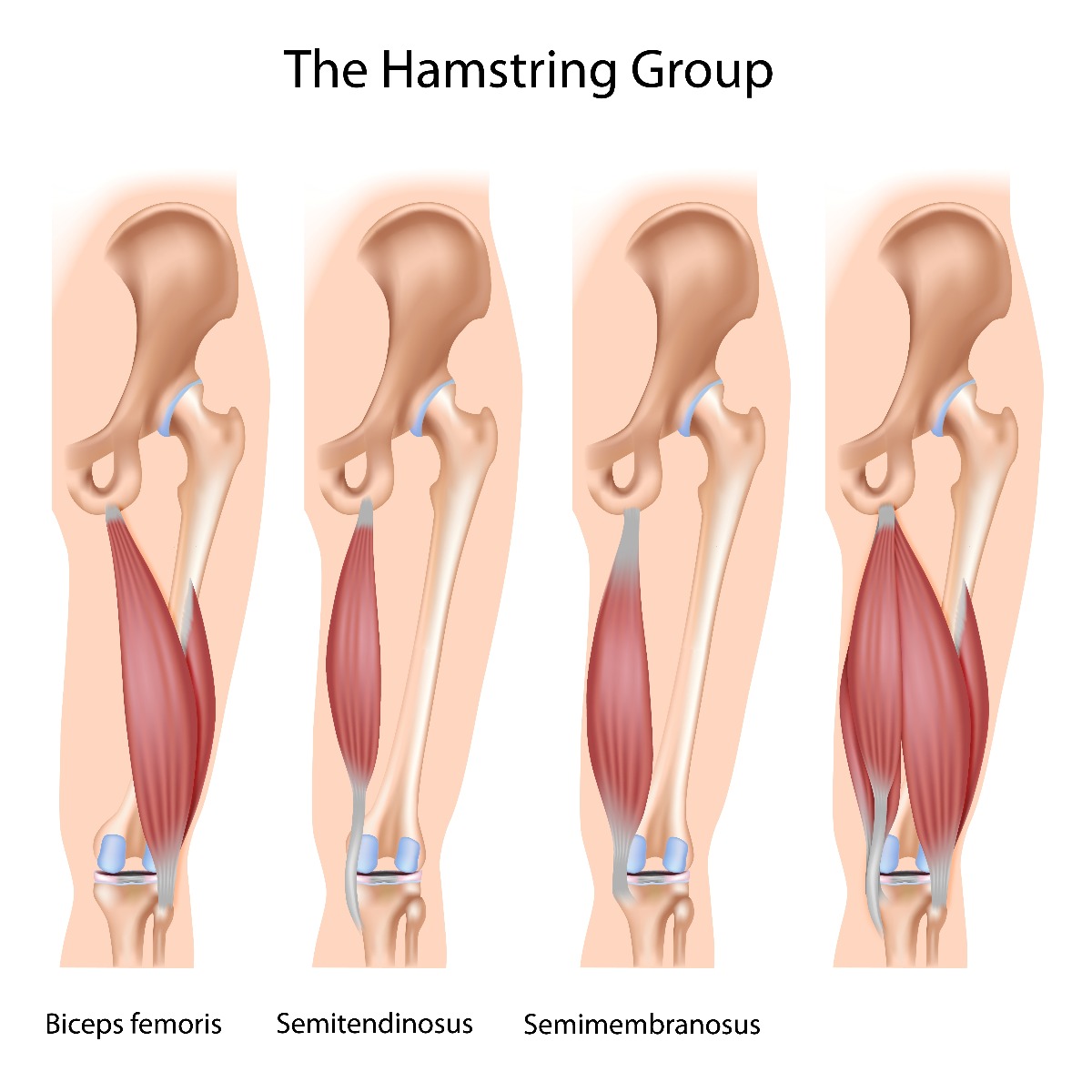
Where is your hamstring?
The hamstring muscle group is actually made of three separate muscles, the semitendinosus, semimembranosus, and biceps femoris. The muscle group runs down the back of your thigh to bend your knees and move your hips. A hamstring strain or “pulled hamstring” is an injury to any of these muscles.
When should I see a doctor?
So now you know where it is and have determined that you have a hamstring injury. Is it severe enough to see a doctor? Muscle strains are graded, from one (mild strain) to three (complete tear). If your pain comes on suddenly and is sharp, if the area is bruised, or if you hear a pop when the injury occurs, it’s time to get checked out by a physician. An aching, chronic injury can often be treated at home.
What causes a hamstring injury?
Muscle overload causes hamstring injuries, either your hamstring was stretched too far or suddenly overloaded. This commonly occurs during sprinting.
What causes a hamstring injury?
- Sprinters and runners
- Athletes who sprint (soccer, track, basketball, and field hockey players)
- Dancers
- Teens who are still growing
Hamstring Injury Treatment
Ice It
The first step of treating a pulled or strained hamstring is to apply ice. You could use an ice pack like the Therapearl Hot & Cold Therapy packs. Ice the area for up to 20 minutes to numb the pain. Another alternative is a CoolXChange wrap. The gel wrap is self-adhesive and can be worn for up to two hours. Cold therapy reduces the inflammation and swelling in your thigh and relieves pain.
Foam Rolling
Foam rolling before and after running puts pressure on your muscles to relieve tightness. Use the TheraBand Pro Foam Roller with an optional TheraBand Foam Roller Wrap to increase the massage pressure. Try this Hamstring Release exercise to work on both legs at the same time. It’s a good choice if you’re sensitive. For more directed pressure, use the Isolated Hamstring Release exercise rolling one leg at a time.
Compression and Running
You can continue to run with chronic and achy pain in your hamstring. Just stick to a slower pace and avoid sprints, intervals, and hills until you have healed. Instead take it easy with a brisk jog or light run. Wear a compression wrap on your thigh during or after a run. The epX Contoured Thigh Support was designed for hamstring strains. It will provide warmth and reduce pain while running.
Cardio Workout Alternatives
If it hurts too much to run or you’re looking for additional cardiovascular activities, try one that will put less stress on your hamstrings. Bicycling and swimming are low-impact exercises that will keep you in shape as you recover.
Prevention
Re-Injury Rate
Over 60% of runners that strain their hamstring will injure it again within a year. That means more pain and more time away from running or more missed games. Luckily, doing hamstring exercises after injury and strengthening the surrounding muscles like your hips, glutes, and abs can help prevent future strains.
Three Hamstring Rehab Exercises
A TheraBand Professional Resistance Band is versatile enough be used for all of the exercises below. You can choose a latex or latex-free resistance band. Another option is a TheraBand Resistance Band Kits, which are available in a Beginner Kit and an Advanced Kit of progressive resistances. This is helpful because then you’re prepared to move to the next level as you grow stronger. Start with these exercises.
Warm up with the TheraBand Hamstring Stretch

- Lay flat on your back. (This might be more comfortable on a yoga mat)
- Loop the band around one foot
- Hold the other end in your hands
- Pull your leg upwards
- Hold for a nice stretch
- Lower your leg slowly
Work your hamstring while laying down with the TheraBand Hamstring Curl in Prone exercise.
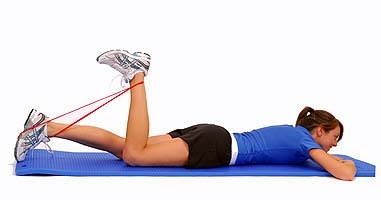
- Lay on your stomach
- Wrap one end of the loop around your left foot and the other around your right ankle
- Keep your left foot against the mat for stabilization
- Bend your right knee, raising your foot
- Hold and slowly release
- Repeat ten times and switch to the opposite leg
You can also strengthen your hamstring and improve your balance with the TheraBand Hamstring Curl in Standing exercise.
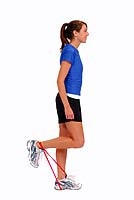
- Loop the resistance band around your left foot and stand on it
- Loop the other end around your right ankle
- Bend your right knee to raise your foot
- Hold and then return your foot to the floor
- Keep your back straight during this exercise
- Repeat ten times and then switch to exercise your left hamstring
It’s important to exercise both hamstrings to keep your muscles balanced. Don’t focus only on the previously injured side.
Additional Exercises
Surrounding muscles work alongside your hamstrings. You can use your TheraBand resistance band to strengthen them as well. Work your hips with the TheraBand Hip Abduction exercise, your glutes with a TheraBand Knee Squats exercise, and your core with the TheraBand Abdominal Crunch exercise. These exercises will help prevent future hamstring strains.
A hamstring injury shouldn’t sideline you from running or playing football, field hockey, or soccer. Always stretch before you start working out and when in doubt, stop and assess a possible injury early. Be sure to strengthen your hamstrings after you have recovered to minimize your chance of a repeat injury or tear.
References
Michaud, T. C. (2017, July 24). The Best Ways to Treat Hamstring Injuries. Retrieved from https://bit.ly/1fMvPAV
Medical Disclaimer: The information provided on this site, including text, graphics, images and other material, are for informational purposes only and are not intended to substitute for professional medical advice, diagnosis or treatment. Always seek the advice of your physician or other healthcare professional with any questions or concerns you may have regarding your condition.
Key Takeaways
- A “pulled hamstring” is an injury to the semitendinosus, semimembranosus, or biceps femoris in the muscle group.
- An aching, chronic hamstring injury can often be treated at home.
- Over 60% of runners that strain their hamstring will injure it again within a year.
- Recommend these exercises to patients in need of hamstring pain relief!
Top Products in This Article
When you have a patient with hamstring pain, you know it needs to be treated now. Your patients who wait until the pain worsens only end up lengthening their recovery time. Share these hamstring recovery tips and exercises with runners who are ready to hit the track without pain.
Frequently Asked Questions
Hamstring Injury Treatment
Prevention and Hamstring Rehab Exercises
Additional Exercises
Frequently Asked Questions
Where is your hamstring?
The hamstring muscle group is actually made of three separate muscles, the semitendinosus, semimembranosus, and biceps femoris. The muscle group runs down the back of the thigh to bend the knees and move the hips. A hamstring strain or “pulled hamstring” is an injury to any of these muscles.

When should you see a doctor?
Understanding how to identify a nagging hamstring injury is helpful, but is it severe enough to see a doctor? Muscle strains are graded, from one (mild strain) to three (complete tear). If your pain comes on suddenly and is sharp, if the area is bruised, or if you hear a pop when the injury occurs, it’s time to get checked out by a physician. An aching, chronic injury can often be treated at home, depending on what your healthcare provider decides.
What causes hamstring injuries?
Muscle overload causes hamstring injuries, either your hamstring was stretched too far or suddenly overloaded. This commonly occurs during sprinting. Physical and occupational therapists often see these patients at risk of pain in the hamstring:
- Sprinters and runners
- Athletes who sprint (soccer, track, basketball, and field hockey players)
- Dancers
- Teens who are still growing
Hamstring Injury Treatment
The Cleveland Clinic states "Do at-home treatments slowly at first, being careful to follow your healthcare provider’s recommendations. While it may take just a few days to a few months for you to heal, remember that you should take steps to prevent a hamstring injury from happening again. Don’t rush your healing."
Ice It
When dealing with a pulled or sore hamstring muscle, the first step of treating the injury is to apply ice. It is recommended that patients ice the area for up to 20 minutes to numb the pain. Try using the TheraPearl Color Changing Hot & Cold Packs to secure an ice pack to the affected area. Cold therapy reduces the inflammation and swelling in the thigh and provides sore hamstring relief.
Foam Rolling
Foam rolling before and after running puts pressure on sore hamstring muscles to relieve tightness. Foam rollers provide deep tissue pressure to ease tight muscles and prevent fatigue and inflammation. Try the THERABAND Pro Foam Roller or the THERABAND Roller Massager+ with raised sections to target pressure points and provide a deeper massage for hamstring strain.
Compression and Running
PTs and OTs are often asked, “Is it ok to run with hamstring pain?” While runners often continue their activities with chronic and achy pain in their hamstrings, it’s best to stick to a slower pace and avoid sprints, intervals, and hills until the injury has healed. Instead take it easy with a brisk jog or light run. Wearing a compression wrap on the thigh can provide warmth and reduce pain during or after a run. The epX Contoured Thigh Support was designed for hamstring strains.
Cardio Workout Alternatives
Overworked hamstrings could mean it’s time to look for additional cardiovascular activities that put less stress on the hamstrings. Bicycling and swimming are low-impact exercises that will keep athletes in shape as they recover.
Prevention and Hamstring Rehab Exercises
Re-Injury Rate
Over 60% of runners that strain their hamstring will injure it again within a year. That means more pain and more time away from running or more missed games. Luckily, doing hamstring exercises after injury and strengthening the surrounding muscles like the hips, glutes, and abs can help prevent future strains.
Five Hamstring Rehab Exercises
A THERABAND Professional Resistance Band is versatile enough be used for all of the exercises below, and comes in latex or latex-free band options. Another option is a Beginner or Advanced THERABAND Resistance Band Kit, which comes with different progressive resistances. As the hamstring muscles strengthen, move up to the next level of resistance.
Try these exercises to relieve hamstring pain at home!
Warm up with the THERABAND Hamstring Stretch.
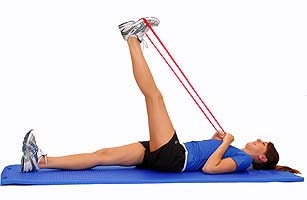
- Lay flat on your back. (This might be more comfortable on a yoga mat)
- Loop the band around one foot
- Hold the other end in your hands
- Pull your leg upwards
- Hold for a nice stretch
- Lower your leg slowly
Work your hamstring while laying down with the THERABAND Hamstring Curl in Prone exercise.

- Lay on your stomach
- Wrap one end of the loop around your left foot and the other around your right ankle
- Keep your left foot against the mat for stabilization
- Bend your right knee, raising your foot
- Hold and slowly release
- Repeat ten times and switch to the opposite leg
You can also strengthen your hamstring and improve your balance with the THERABAND Hamstring Curl in Standing exercise.

- Loop the resistance band around your left foot and stand on it
- Loop the other end around your right ankle
- Bend your right knee to raise your foot
- Hold and then return your foot to the floor
- Keep your back straight during this exercise
- Repeat ten times and then switch to exercise your left hamstring
Another way to relieve pain after a hamstring running injury is with the THERABAND Pro Foam Roller Hamstring Release.
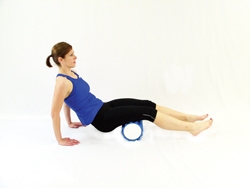
- Sit on the floor behind the Pro Foam Roller with both thighs draped across the roller
- Keep your hands planted on the floor, lift your buttocks up to roll the length of the hamstring muscles back and forth over the roller
- For a deeper release, stack the left leg on top of the right leg and roll with long, sweeping strokes
- Work in shorter repetitive strokes for tight hamstring relief and repeat for the opposite leg
For focused relief for hamstring pain, try the THERABAND Pro Foam Roller Isolated Hamstring Release.
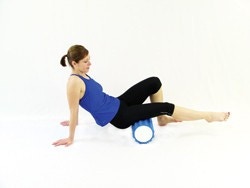
- Sit on the floor behind the Pro Foam Roller
- To isolate and control the release of the right hamstring muscle, scoot to the far edge of the roller with the right thigh across the roller and the left foot planted on the floor
- Plant your hands and lift the buttocks up to roll the length of the hamstring muscle
- For a deeper release to the lateral hamstrings, slowly allow the right leg to turn out while rolling and slowly return to neutral
- For a deeper release to the medial hamstrings, slowly allow the right leg to turn in while rolling, slowly returning to a neutral position
- Repeat the process for the left hamstring
It’s important to exercise both hamstrings to keep your muscles balanced. Don’t focus only on the previously injured side.
Additional Exercises
Surrounding muscles work alongside your hamstrings. You can use your THERABAND Resistance Band to strengthen them as well. Work your hips with the THERABAND Hip Abduction exercise, your glutes with a THERABAND Knee Squats exercise, and your core with the THERABAND Abdominal Crunch exercise. These exercises will help prevent future strains and allow you to return to running after a hamstring injury.
Sore hamstring muscles shouldn’t sideline you from running or playing football, field hockey, or soccer. Always stretch before you start working out and when in doubt, stop and assess a possible injury early. Be sure to strengthen your hamstrings after you have recovered to minimize your chance of a repeat injury or tear.
References
Michaud, T. C. (2017, July 24). The Best Ways to Treat Hamstring Injuries. Retrieved from https://cle.clinic/3Q7xg6V
Medical Disclaimer: The information provided on this site, including text, graphics, images and other material, are for informational purposes only and are not intended to substitute for professional medical advice, diagnosis or treatment. Always seek the advice of your physician or other healthcare professional with any questions or concerns you may have regarding your condition.








 France
France Australia
Australia